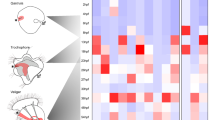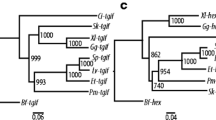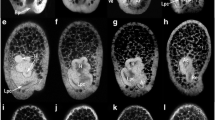Abstract
Convergence is a significant evolutionary phenomenon. Arrival at similar morphologies from different starting points indicates a strong role for natural selection in shaping morphological phenotypes. There is no evidence yet of convergence in the developmental mechanisms that underlie the evolution of convergent developmental phenotypes. Here we report the expression domains in sea urchins of two important developmental regulatory genes (Orthodenticle and Runt), and show evidence of molecular convergence in the evolution of direct-developing sea urchins. Indirect development is ancestral in sea urchins. Evolutionary loss of the feeding pluteus stage and precocious formation of the radially symmetric juvenile has evolved independently in numerous sea urchin lineages, thus direct development is an evolutionary convergence. Indirect-developing species do not express Otx during the formation of their five primordial tube feet, the ancestral condition. However, each direct-developing urchin examined does express Otx in the tube feet. Otx expression in the radial arms of direct-developing sea urchins is thus convergent, and may indicate a specific need for Otx use in direct development, a constraint that would make direct development less able to evolve than if there were multiple molecular means for it to evolve. In contrast, Runt is expressed in tube feet in both direct- and indirect-developing species. Because echinoderms are closely related to chordates and postdate the protostome/deuterostome divergence, they must have evolved from bilaterally symmetrical ancestors. Arthropods and chordates use Otx in patterning their anterior axis, and Runt has multiple roles including embryonic patterning in arthropods, and blood and bone cell differentiation in vertebrates. Runt has apparently been co-opted in echinoderms for patterning of pentamery, and Otx in pentameral patterning among direct-developing echinoids. The surprisingly dynamic nature of Otx evolution reinvigorates debate on the role of natural selection vs shared ancestry in the evolution of novel features.








Similar content being viewed by others
References
Acampora D, Simeone A (1999) The TINS lecture. Understanding the roles of Otx1 and Otx2 in the control of brain morphogenesis. Trends Neurosci 22:116–122
Acampora D, Avantaggiato V, Tuorto F, Barone P, Reichert H, Finkelstein R, Simeone A (1998) Murine Otx1 and Drosophila otd genes share conserved genetic functions required in invertebrate and vertebrate brain development. Development 125:1691–1702
Adachi Y, Nagao T, Saiga H, Furukubo-Tokunaga K (2001) Cross-phylum regulatory potential of the ascidian Otx gene in brain development in Drosophila melanogaster. Dev Genes Evol 211:269–280
Angerer LM, Angerer RC (1991) Localization of mRNAs by in situ hybridization. Methods Cell Biol 35:37–71
Angerer LM, Oleksyn DW, Levine AM, Li X, Klein WH, Angerer RC (2001) Sea urchin goosecoid function links fate specification along the animal and oral-aboral embryonic axes. Development 128:4393–4404
Bruce AE, Shankland M (1998) Expression of the head gene Lox22-Otx in the leech Helobdella and the origin of the bilaterian body plan. Dev Biol 201:101–112
Coffman JA, Kirchhamer CV, Harrington MG, Davidson EH (1996) SpRunt-1, a new member of the runt domain family of transcription factors, is a positive regulator of the aboral ectoderm-specific CyIIIA gene in sea urchin embryos. Dev Biol 174:43–54
Damen WG, Weller M, Tautz D (2000) Expression patterns of hairy, even-skipped, and runt in the spider Cupiennius salei imply that these genes were segmentation genes in a basal arthropod. Proc Natl Acad Sci USA 97:4515–4519
Emlet RB (1990) World patterns of developmental mode in echinoid echinoderms. In: Hoshi M, Yamashita O (eds) Advances in invertebrate reproduction, vol 5. Elsevier, Tokyo
Emlet RB (1995) Developmental mode and species geographic range in regular sea urchins (Echinodermata: Echinoidae). Evolution 49(3):476-489
Ferkowicz MJ, Raff RA (2001) Wnt gene expression in sea urchin development: heterochronies associated with the evolution of developmental mode. Evol Dev 3:24–33
Finkelstein R, Smouse D, Capaci TM, Spradling AC, Perrimon N (1990) The orthodenticle gene encodes a novel homeodomain protein involved in the development of the Drosophila nervous system and ocellar visual structures Genes Dev 4:1516–1527
Fossett N, Schulz RA (2001) Functional conservation of hematopoietic factors in Drosophila and vertebrates. Differentiation 69:83–90
Gergen JP, Butler BA (1988) Isolation of the Drosophila segmentation gene runt and analysis of its expression during embryogenesis. Genes Dev 2:1179–1193
Guillard RRL (1972) Culture of phytoplankton for feeding marine invertebrates. In: Smith WL, Chanley MH (eds) Culture of marine invertebrate animals. Plenum Press, New York, pp 29–60
Haag ES, Raff RA (1998) Isolation and characterization of three mRNAs enriched in embryos of the direct-developing sea urchin Heliocidaris erythrogramma: evolution of larval ectoderm. Dev Genes Evol (4):188–204
Harada Y, Okai N, Taguchi S, Tagawa K, Humphreys T, Satoh N (2000) Developmental expression of the hemichordate otx ortholog. Mech Dev 91:337–339
Hart M (2002) Life history evolution and comparative developmental biology of echinoderms. Evol Dev 4:62–71
Henry JJ, Raff RA (1990) Evolutionary change in the process of dorsoventral axis determination in the direct developing sea urchin, Heliocidaris erythrogramma. Dev Biol 141:55–69
Hirth F, Reichert H (1999) Conserved genetic programs in insect and mammalian brain development. Bioessays 21:677–684
Isaacs HV, Andreazzoli M, Slack JMW (1999) Anteroposterior patterning by mutual repression of orthodentical and caudal-type transcription factors. Evol Dev 1:143–152
Kammermeier L, Reichert H (2001) Common developmental genetic mechanisms for patterning invertebrate and vertebrate brains. Brain Res Bull 55:675–682
Klueg KM, Harkey MA, Raff RA (1997) Mechanisms of evolutionary changes in timing, spatial expression, and mRNA processing in the msp130 gene in a direct-developing sea urchin, Heliocidaris erythrogramma. Dev Biol 182:121–133
Leuzinger S, Hirth F, Gerlich D, Acampora D, Simeone A, Gehring WJ, Finkelstein R, Furukubo-Tokunaga K, Reichert H (1998) Equivalence of the fly orthodenticle gene and the human OTX genes in embryonic brain development of Drosophila. Development 125:1703–1710
Li X, Chuang CK, Mao CA, Angerer LM, Klein WH (1997) Two Otx proteins generated from multiple transcripts of a single gene in Strongylocentrotus purpuratus. Dev Biol 187:253–266
Li X, Wikramanayake AH, Klein WH (1999) Requirement of SpOtx in cell fate decisions in the sea urchin embryo and possible role as a mediator of beta-catenin signaling. Dev Biol 212:425–439
Littlewood DTJ, Smith AB (1995) A combined morphological and molecular phylogeny for sea urchins (Echinoidea: Echinodermata). Philos Trans R Soc Lond B 347:213–234
Logan CY, Miller JR, Ferkowicz MJ, McClay DR (1999) Nuclear beta-catenin is required to specify vegetal cell fates in the sea urchin embryo. Development 126:345–357
Lowe CJ, Wray GA (1997) Radical alterations in the roles of homeobox genes during echinoderm evolution. Nature 389:718–721
Minsuk SB, Raff RA (2002) Pattern formation in a pentameral animal: induction of early adult rudiment development in sea urchins. Dev Biol 247:335–350
Muller P, Yanze N, Schmid V, Spring J (1999) The homeobox gene Otx of the jellyfish Podocoryne carnea: role of a head gene in striated muscle and evolution. Dev Biol 216:582–594
Nagao T, Leuzinger S, Acampora D, Simeone A, Finkelstein R, Reichert H, Furukubo-Tokunaga K (1998) Developmental rescue of Drosophila cephalic defects by the human Otx genes. Proc Natl Acad Sci USA 95:3737–3742
Nielsen MG, Wilson KA, Raff EC, Raff RA (2000) Novel gene expression patterns in hybrid embryos between species with different modes of development. Evol Dev 2:133–144
Pancer Z, Rast JP, Davidson EH (1999) Origins of immunity: transcription factors and homologues of effector genes of the vertebrate immune system expressed in sea urchin coelomocytes. Immunogenetics 49:773–786
Peterson KJ, Arenas-Mena C, Davidson EH (2000) The A/P axis in echinoderm ontogeny and evolution: evidence from fossils and molecules. Evol Dev 2:93–101
Raff RA (1987) Constraint, flexibility, and phylogenetic history in the evolution of direct development in sea urchins. Dev Biol 119:6–19
Raff RA, Sly BJ (2000) Modularity and dissociation in the evolution of gene expression territories in development. Evol Dev 2:102–113
Sakamoto N, Akasaka K, Mitsunaga-Nakatsubo K, Takata K, Nishitani T, Shimada H (1997) Two isoforms of orthodenticle-related proteins (HpOtx) bind to the enhancer element of sea urchin arylsulfatase gene. Dev Biol 181:284–295
Shoguchi E, Harada Y, Numakunai T, Satoh N (2000) Expression of the otx gene in the ciliary bands during sea cucumber embryogenesis. Genesis 27(2):58–63
Smith AB (1984) Echinoid palaeobiology. Allen and Unwin, London
Stornaiuolo A, Bayascas J, Salo E, Boncinelli E (1998) A homeobox gene of the orthodenticle family is involved in antero-posterior patterning of regenerating planarians. Int J Dev Biol 42:1153–1158
Strathman RR (1978) The evolution and loss of feeding larval stages of marine invertebrates. Evolution 32:894–906
Strathmann RR (1985) Feeding and non-feeding larval development and life-history evolution in marine invertebrates. Ann Rev Ecol Syst 16:339–361
Tsai CC, Kramer SG, Gergen JP (1998) Pair-rule gene runt restricts orthodenticle expression to the presumptive head of the Drosophila embryo. Dev Genet 23:35–44
Ubish L von (1913) Die Entwicklung von Strongylocentrotus lividus (Echinus microtuberculatus, Arbacia pustulosa). Z Wiss Zool 106:409–448
Villinski JT, Villinski JC, Byrne M, Raff RA (2003) Convergent maternal provisioning and life-history evolution in echinoderms. Evolution 56(9):1764–1775
Wada S, Katsuyama Y, Sato Y, Itoh C, Saiga H (1996) Hroth an orthodenticle-related homeobox gene of the ascidian, Halocynthia roretzi: its expression and putative roles in the axis formation during embryogenesis. Mech Dev 60:59–71
Westendorf JJ, Hiebert SW (1999) Mammalian runt-domain proteins and their roles in hematopoiesis, osteogenesis, and leukemia. J Cell Biochem Suppl:51–58
Wikramanayake AH, Huang L, Klein WH (1998) Beta-catenin is essential for patterning the maternally specified animal-vegetal axis in the sea urchin embryo. Proc Natl Acad Sci USA 495:9343–9348
Williams DHC, Anderson DT (1975) The reproductive system, embryonic development, larval development, and metamorphosis of the sea urchin Heliocidaris erythrogramma (Val.) (Echinoidea: Echinometridae). Aust J Zool 23:371–403
Williams NA, Holland PW (1998) Gene and domain duplication in the chordate Otx gene family: insights from amphioxus Otx. Mol Biol Evol 15:600–607
Wray GA, Bely AE (1994) The evolution of echinoderm development is driven by several distinct factors. Development Suppl:97–106
Wray GA, Lowe CJ (2000) Developmental regulatory genes and echinoderm evolution. Syst Biol 49:28–51
Yuh CH, Li X, Davidson EH, Klein WH (2001) Correct expression of spec2a in the sea urchin embryo requires both Otx and other cis-regulatory elements. Dev Biol 15(232):424–438
Acknowledgements
This work was funded in part by NIH and NSF grants to R.A. Raff.
Author information
Authors and Affiliations
Corresponding author
Additional information
Edited by D. Tautz
Rights and permissions
About this article
Cite this article
Nielsen, M.G., Popodi, E., Minsuk, S. et al. Evolutionary convergence in Otx expression in the pentameral adult rudiment in direct-developing sea urchins. Dev Genes Evol 213, 73–82 (2003). https://doi.org/10.1007/s00427-003-0299-7
Received:
Accepted:
Published:
Issue Date:
DOI: https://doi.org/10.1007/s00427-003-0299-7




